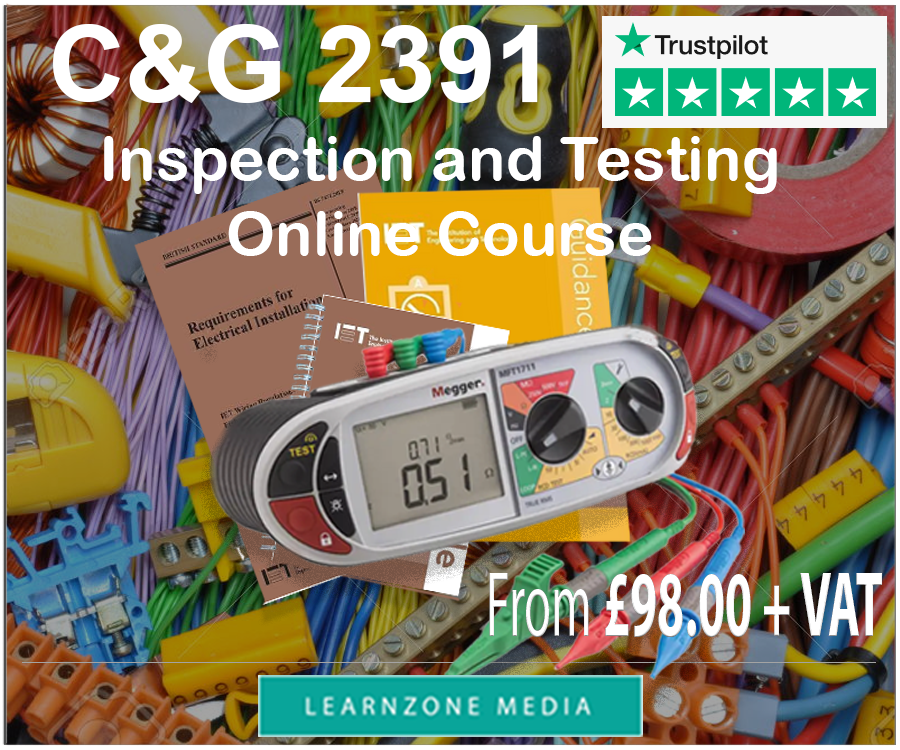C&G 2391 Unit 301 - Sample Test No:1
21. Who is most at risk when an inspector fails to isolate a lighting circuit before removing a luminaire cover to carry out an inspection?
a) The inspector
b) Other operatives
c) The general public
d) The client
22. Which publication specifically identifies the need for electrical installations to be safe for use and maintained in that condition?
a) HSE Guidance GS 38
b) Electricity at Work Regulations
c) The Health and Safety at Work Act
d) Electricity Safety, Quality and Continuity Regulations
23. Before commencing live tests and before energising the installation, it is vital that you:
a) Inform other people in the area
b) Disconnect the earth conductor from the Main Earth Terminal
c) Evacuate the area of the general public
d) Erect barriers around the testing area
24. A room in which there is a 13 A socket outlet is to be converted into a bathroom. The socket outlet must be:
a) removed from the room
b) moved to become a ceiling socket outlet
c) fitted with a switch
d) moved so as to be more than 3 m from the bath
25. Where vertical trunking passes through floors internal fire resistant barriers must be:
a) at maximum intervals of 3 m
b) only at the top of the trunking
c) at each floor level
d) mid-way between each floor
26. Electrical test probes must comply with standards set by:
a) BS 7671
b) GN 3
c) Guidance Note GS 38
d) BS EN 60598.
27. A visual inspection of a new installation must be carried out:
a) upon completion
b) during testing
c) during erection
d) during erection and upon completion
28. A permanent label to BS 951 should be fixed in a visible position at points of connection to every earth electrode or bonding position. The wording on the label should state:
a) Safety Earth Connection - Do Not Remove
b) Safety Earth Point - Do Not Remove
c) Safety Electrical Connection - Do Not Remove
d) Safety Earthing Connection -Do Not Remove
29. During inspection of a distribution board containing exposed conductive parts it should be verified that:
a) The board is situated at least 2 metres above ground level
b) The board has a handle and the door is shut
c) The door can only be opened with a key or tool
d) The board has at least protection to IP2X
30. The proposed interval between the first periodic inspection and future inspections should be recommended by:
a) the person carrying out the initial verification
b) the person who designed the installation
c) the installation engineer
d) the person carrying out the first periodic inspection
31. Which publication specifically identifies the requirements for test leads and probes to be used when carrying out tests at 230V a.c. ?
a) BS 7671
b) HSE Guidance GS 38
c) Electricity at Work Regulations
d) Provision and Use of Work equipment Regulations
32. Which test would be used to confirm that exposed conductive parts are connected to the main earthing terminal?
a) Insulation resistance
b) Prospective fault current
c) Earth fault loop impedance
d) Continuity of protective conductors
33. Which test is used to confirm the correct connection of a three phase socket outlet?
a) Phase sequence
b) Insulation resistance
c) Earth fault loop impedance
d) Functional testing
34. Which test is required to confirm the correct operation of a 30mA RCBO installed to provide additional protection?
a) Phase sequence
b) Insulation resistance
c) Earth fault loop impedance
d) Operation of residual current devices
35. It is important to test a new installation in the correct sequence because:
a) The sequence is stated in GN3
b) Each test relies on the previous to be correct
c) It is more convenient
d) It is easy to remember
36. The insulation resistance of two circuits is of 40MΩ and 36MΩ respectively. When tested together what would be approximately the total insulation resistance:
a) 1440 MΩ
b) 76 MΩ
c) 19 MΩ
d) 4 MΩ
37. When performing an insulation test on a 230V domestic ring circuit, what level of test voltage is required:
a) 230V
b) 500V
c) 110V
d) 50V
38. Records of all checks, inspections and tests to an installation should be kept:
a) for one year
b) for 3 years
c) for 10 years
d) for the working life of the installation
39. Faults within existing installations which 'do not' effect new additions to the installation:
a) Are required to be noted if observed by the engineer doing the new additions
b) Are required to be corrected by the engineer doing the new additions
c) Do not need to be corrected by the engineer doing the new additions
d) Are required to be reported to the local building authority by the additions engineer
40. The maximum prospective fault current recorded on an electrical installation certificate should be:
a) The greater of either the short-circuit current or the earth fault current
b) The lesser of either the short-circuit current or the earth fault current
c) The short-circuit current.
d the earth fault current.






